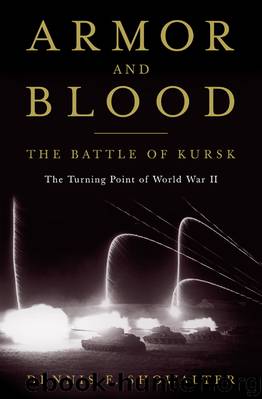Armor and Blood by Dennis E. Showalter

Author:Dennis E. Showalter [Showalter, Dennis E.]
Language: eng
Format: epub
ISBN: 978-0-8129-9465-0
Publisher: Random House Publishing Group
Published: 2013-08-26T16:00:00+00:00
IV
Nikolai Vatutin did not survive the war. He was mortally wounded in February 1944—ironically by a band of anti-Soviet Ukrainian partisans. He left no systematic reflections on his handling of the Voronezh Front during Citadel. But on the evening of July 9, he did some serious thinking. The German spearheads were still a good distance from Oboyan and Prokhorovka. In the past two days, however, they had advanced at a much faster and steadier pace than at Citadel’s beginning. Logic—and the Red Army approached war making as a scientific, rational exercise—suggested that losses should have been slowing them down. Vatutin had been committing his own reserves by corps, divisions, regiments, and battalions, for five days. Ten of his antitank regiments had lost all their guns; twenty more were at less than half strength. Logic suggested either that the Germans were bringing in reserves—or that their shock power and fighting prowess were proving a match and more for Vatutin’s men. Front intelligence, moreover, had been asserting the arrival and commitment of fresh German forces since the night of July 5.
Vatutin considered his front’s tactics. In Citadel’s early stages, they had featured an active defense. Short, sharp, tank-heavy counterattacks had bloodied German noses and retarded their progress. On July 8 and 9, casualties and material losses combined with fog and friction to impose a passive approach. What were the prospects of shifting back to an aggressive mode?
Reevaluating the intelligence, Vatutin and his staff noticed reports overlooked in the previous days’ intensive fighting. As early as 7:00 A.M. on July 8, the Germans were described as constructing trenches on their steadily lengthening left flank. By July 9, trenches were emerging on both flanks of the salient, supplemented by mines and barbed wire, suggesting long-term occupation. A disgruntled German prisoner said he was one of thirty men from a veterinary company condignly transferred to a flank-guard infantry regiment: a sign the Germans were scraping the manpower barrel.
Were these straws in the wind? Perhaps. For Vatutin, they were sufficient to conclude that the recent German progress had been achieved by concentrating their mechanized forces at the expense of their flanks. That in turn meant the panzers were thrusting their own heads into a noose: a salient within a salient. How best to take advantage of the developing situation? In a map exercise, the answer was clear—strike the overextensions. But Voronezh Front’s realities made that option a nonstarter. The Germans had Vatutin’s main forces no less pinned in place than they were themselves. A counterattack in force would require the just released Stavka reserves. And Fifth Guards and Fifth Guards Tank Armies were concentrating at the salient’s tip: around Prokhorovka. Even had Vatutin considered redeploying them, there was no time. He and his front were the balance point for the entire sequence of strategic offensives from Leningrad to the Ukraine, projected to end the Russo-German War by the turn of the year. The first—or next—phase, Operation Kutuzov, was planned to begin against Army Group Center on July 12.
Download
This site does not store any files on its server. We only index and link to content provided by other sites. Please contact the content providers to delete copyright contents if any and email us, we'll remove relevant links or contents immediately.
| Africa | Americas |
| Arctic & Antarctica | Asia |
| Australia & Oceania | Europe |
| Middle East | Russia |
| United States | World |
| Ancient Civilizations | Military |
| Historical Study & Educational Resources |
Journey to the Abyss by Harry Kessler(1342)
Armor and Blood by Dennis E. Showalter(940)
Hitler 1889-1936: Hubris by Ian Kershaw(863)
The Celestine Prophesy by James Redfield(808)
The Cello Suites by Eric Siblin(768)
1989 by Peter Millar(729)
Albert Speer: His Battle With Truth by Gitta Sereny(685)
Journey to the Abyss: The Diaries of Count Harry Kessler, 1880-1918 by Harry Kessler(667)
1938 by Giles MacDonogh(548)
Einstein in Berlin by Thomas Levenson(538)
The First and the Last by Adolf Galland(525)
DK Eyewitness Travel Guide Germany by DK Travel(523)
Hitler by Unknown(505)
Germany (Lonely Planet, 6th Edition) by unknow(467)
Grey Wolf: The Escape of Adolf Hitler by Simon Dunstan & Gerrard Williams(464)
Unholy Alliance: A History of Nazi Involvement With the Occult (New and Expanded Edition) by Peter Levenda(441)
The Nazis – A Warning from History by Laurence Rees(401)
Hitler Youth by Susan Campbell Bartoletti(401)
Groundwork for the Metaphysics of Morals by Immanuel Kant(390)
